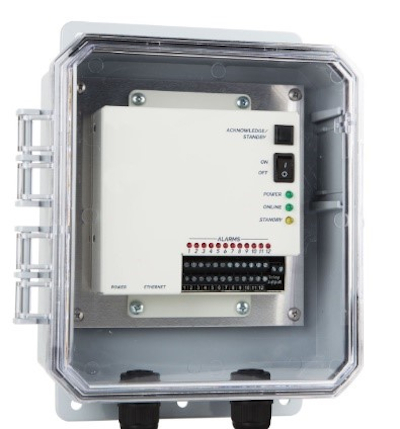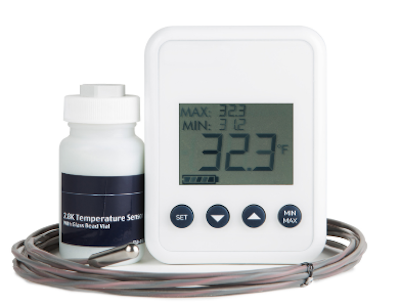Many vaccines and pharmaceuticals stored in medical refrigerators and freezers must be held at a precise temperature as required by regulators like the CDC and state and local health departments or instructions from the manufacturer. Even when cold storage temperature is not regulated, it makes sense to protect valuable medications, research samples and specimens from becoming ruined because exact conditions are not maintained.
The most effective way to do this is to equip medical refrigerators and freezers with continuous temperature monitoring devices. A monitoring system can detect problems such as unexpected temperature changes inside the unit, power outages, unauthorized access and doors left open for an extended time. The system sends alerts via email, phone call or text message to designated personnel when conditions fall outside of the preset range. Today’s monitoring systems can protect multiple refrigerators and freezers.
Data Logging Advantage
One of the greatest features of a remote monitoring system is that it can also function as a data logger.
This means no more posting a log sheet on each refrigerator and freezer and having to remember to manually record the temperature at a set time each day. Digital loggers keep a record of all the temperature data, so operators can download it as needed to prove compliance or look for trends that might indicate the refrigerator or freezer is malfunctioning.
Spotting potential problems is easier with access to the big picture. Because the data logger monitors trends, users can identify activities or problems that might be causing temperature changes. For example, the data log might show power fluctuations occurring at regular intervals, indicating a situation that should be investigated.

Figure 1: Cloud-based digital data logger sends data to users to view in real-time.
How Digital Data Loggers Work
Data loggers communicate with sensors at a set interval and automatically record data points, dates and times. Manually monitoring and gathering this data risks inaccurately recording the information, takes a significant amount of personnel time and detracts from other important workplace demands.
Cloud-based digital data loggers automatically send the collected data to an online dashboard for users to view in real time. These systems can store and provide an unlimited number of records. That’s because cloud technology is supported by networks of remote servers, rather than local computers, that manage and store vast amounts of data. This enables users of digital data loggers to view the status of multiple locations, access trending reports, check specific equipment status and review alarm history without having to install any software.
Providers of advanced monitoring systems use private cloud services that are not shared with the public. These providers monitor the cloud platform around the clock and have multiple backup server sites across the country to ensure the system is never down.

Figure 2: Cloud-based monitoring device and data logger in protective enclosure.
Cloud-based units constantly communicate a signal to the cloud to validate their online status. If the communication link is interrupted—for example by a power outage or an employee accidentally switching off the unit—the system generates an alarm indicating that the internet connection is lost or that there is a cellular communications problem. Users are alerted about the disruption through phone, text or email. All data collected during this time will be stored in the device and will be uploaded to the cloud when the internet connection is restored.
There are a few different ways of accessing sensor readings and data. With a cloud-based system, users can monitor real-time status, make programming changes, and review data logs on a mobile device via a web page or app. If the system is not cloud-based, users have to log in through a local area network to access status conditions.
Sensors and Placement
To monitor the temperature of inventory inside the refrigerator or freezer, it is best to use a probe calibrated to National Institute of Standards and Technology (NIST) standards and buffered in a bottle filled with either glycol or glass beads. The buffer ensures that temperature readings represent the temperature of the unit’s contents rather than the ambient air.
Buffers act as a cushion against temperature fluctuations in a freezer or refrigerator. Without a buffer, the probe measures the atmosphere inside the unit, which can change rapidly with defrost cycles, opening of the door or fans circulating the air. The ambient air temperature inside the unit changes more quickly than the temperature of vaccines, pharmaceuticals and medical specimens, so a buffered probe more accurately represents the temperature of the stored products.

Figure 3: Temperature probe with buffer and display unit.
Using a probe that is connected to a temperature display, which is placed on the outside of the unit, provides on-site staff with a quick, convenient visual reading of the sensor. This saves staff the time of checking the monitoring system's data logs. The temperature display shows and logs the highest and lowest temperatures and provides an audible alarm for out-of-range temperatures. The display can also be programmed to turn on a light or siren for additional on-site alarm notifications. These alarms are in addition to the alerts that the monitoring system sends to designated personnel when temperatures fall out of range.
NIST Traceable Calibration
For the cold storage of medical products, it is important that the temperature sensors carry traceable calibration certificates that indicate they comply with standards provided by the NIST, a U.S. Commerce Department agency.
NIST Traceable Calibration Certificates include the necessary information to meet stringent accreditation demands, including serial number, test points and test date. These certificates ensure that a laboratory or manufacturer is fully equipped to calibrate equipment to NIST standards and that products offered by that manufacturer match the NIST-maintained measurement criteria. Certified sensors are necessary for facilities that need to have an audit trail proving their medical inventory is continually stored at specific temperatures. The certification is required for many hospitals, biopharmaceutical companies, research labs, healthcare clinics, blood and tissue banks, pharmacies and other facilities that store medical products and samples.
Conclusion
Cold medical assets like vaccines, pharmaceuticals, medical specimens and research samples are vital to public health, expensive and sometimes irreplaceable. Their temperature has to be maintained the entire time they are stored until they are used. Remote monitoring systems and data loggers protect these assets around the clock and provide an audit trail documenting their correct storage. Today’s monitoring systems are so inexpensive to install and maintain that getting an extra layer of protection on valuable medical assets is now a “no brainer.”
Rob Fusco is Director of Business Development with Sensaphone, a developer and manufacturer of remote monitoring and alerting systems. He can be reached at [email protected] or 877-373-2700.